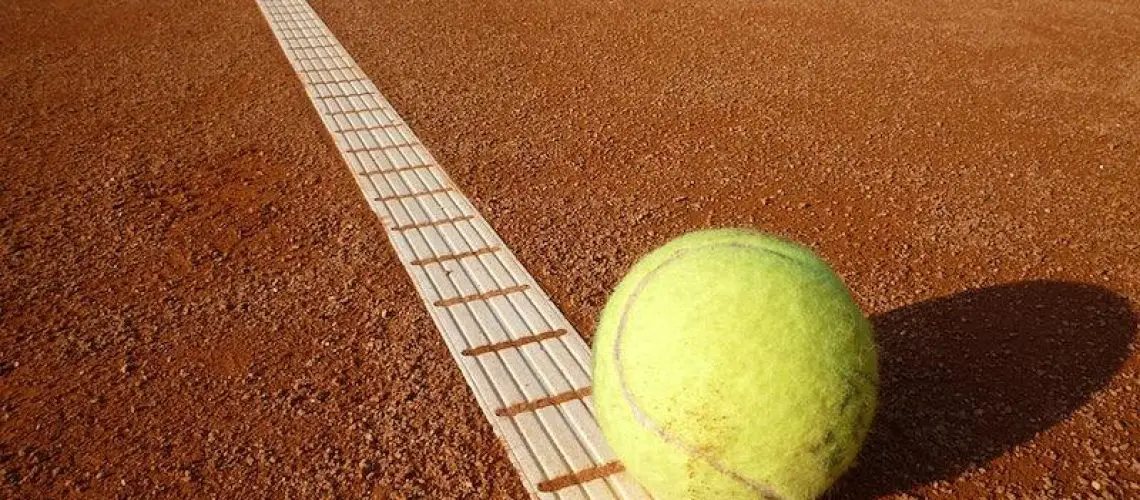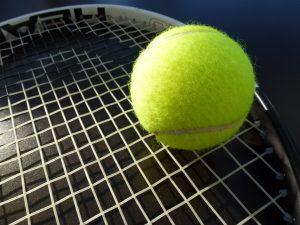We may earn money or products from the companies mentioned in this post.
Brief History of Tennis Balls

When we think of tennis, our minds are filled with images of players gracefully hitting balls back and forth But have you ever wondered how this iconic piece of equipment came to be? Let’s take a journey back in time to explore the fascinating history of tennis balls
Early Materials Used for Tennis Balls
In the early days of tennis, players used a variety of materials for their balls One popular choice was a stuffed leather ball, which was filled with hair or wool These primitive balls were not as bouncy or consistent as modern ones but still provided hours of entertainment on the court
Another material that gained popularity was cork Tennis balls made from cork had a more predictable bounce and were easier to manipulate during gameplay However, they were prone to wear and tear, often losing their shape after repeated use
Evolution of the Modern Tennis Ball
The breakthrough in tennis ball technology came in the late 19th century when Charles Goodyear introduced vulcanized rubber This new material revolutionized the game by providing a durable and elastic core for tennis balls
Vulcanized rubber allowed manufacturers to create balls that had consistent bounce and longevity on the court The outer covering of these modern tennis balls became known as the felt, which is typically made from nylon or wool fibers tightly woven together
Importance of Knowing the Weight of a Tennis Ball

Knowing the weight of a tennis ball may seem like a trivial detail, but it can have significant implications for players’ performance and technique on the court
Impact on Player Performance and Technique
The weight of a tennis ball affects how it moves through the air and interacts with various surfaces A heavier ball will require more strength and force to hit, which can impact a player’s shot accuracy and power On the other hand, a lighter ball may be easier to maneuver but might lack the necessary momentum for powerful shots
Understanding the weight of a tennis ball allows players to adapt their playing style accordingly It helps them gauge how much effort they need to exert in their swings and adjust their footwork to optimize their performance on different court surfaces
Influence on Equipment Choice and Maintenance
The weight of tennis balls also influences equipment choices made by both professional and recreational players Racket manufacturers often design their products with specific ball weights in mind, creating a harmonious balance between the racket and the ball
Additionally, knowing the weight of tennis balls is crucial for maintenance purposes Over time, balls lose pressure and become less lively By monitoring the weight of their balls, players can ensure they are using ones that meet regulation standards and provide consistent playability
Tennis Ball Weight Standards and Regulations

When it comes to tennis, every detail matters – even the weight of the ball The International Tennis Federation (ITF) has set specific standards and regulations for tennis ball weights to ensure fair play and consistent performance on the court
International Tennis Federation (ITF) Specifications
The ITF is the governing body of tennis worldwide, responsible for setting guidelines that maintain uniformity in the sport One such guideline is the official weight range for tennis balls According to ITF regulations, a standard tennis ball should weigh between 56 grams (198 ounces) and 594 grams (210 ounces).
To ensure the quality and integrity of competition-grade balls, the ITF has established strict criteria for their approval These criteria include factors like bounce height, deformation, and durability Only balls that meet these standards are deemed suitable for official tournaments and matches
Types of Tennis Balls Based on Weight Variations
Within the specified weight range, there are different types of tennis balls designed to cater to varying playing conditions and preferences
Extra-Duty Felt vs Regular-Duty Felt:
Tennis balls can be categorized based on the type of felt used on their surface Extra-duty felt balls have a thicker felt covering that makes them more durable and suitable for hard court surfaces On the other hand, regular-duty felt balls have a lighter felt covering which provides better performance on clay or grass courts
High-Altitude vs Regular Altitude Balls:
In areas with high altitudes, such as mountainous regions or places at higher elevations, regular tennis balls tend to fly faster due to reduced air resistance To compensate for this, high-altitude balls are specially designed with lower internal pressure to ensure optimal performance in such conditions
By adhering to these weight standards and regulations, tennis players can enjoy a level playing field and consistent gameplay Whether it’s the choice between extra-duty or regular-duty felt balls or adjusting for high-altitude conditions, understanding these variations allows players to make informed decisions and optimize their performance on the court
Factors Affecting Tennis Ball Weight

When it comes to tennis, every detail counts, including the weight of the ball The weight of a tennis ball can vary based on various factors, from its materials and construction to environmental conditions Let’s delve into these factors and understand how they impact the weight of tennis balls
Materials and Construction
The materials used in constructing a tennis ball play a crucial role in determining its weight Tennis balls are typically made up of two main components: the core and the felt cover
-
Core Components:
The core is usually made of rubber and may contain pressurized air or gas along with specific chemicals This combination affects the overall weight of the ball -
Felt Cover:
The outer layer of a tennis ball is covered with felt, which can be composed of different materials such as wool, nylon, or a blend of cotton fibers The thickness and density of the felt cover also contribute to the ball’s weight
Environmental Factors Impacting Weight Fluctuations
The weight of a tennis ball can fluctuate due to various environmental factors that affect its composition and structure
-
Humidity Absorption:
Tennis balls have microscopic pores that can absorb moisture from their surroundings When exposed to high humidity or prolonged contact with water or damp conditions, these balls tend to gain moisture, resulting in an increase in their weight -
High-Altitude Effects:
Altitude plays a role in affecting the pressure inside a pressurized tennis ball As altitude increases, atmospheric pressure decreases, which can cause fluctuations in the internal pressure within the ball This, in turn, affects the weight of the ball
Understanding these factors is crucial for players and manufacturers alike By considering the materials used and environmental conditions, players can choose tennis balls that suit their playing style and court conditions Manufacturers can also optimize their production processes to ensure consistent weight standards for tennis balls
Practical Applications and Considerations Related to Tennis Ball Weight

Tennis ball weight may seem like a minor detail, but it can have a significant impact on a player’s style and strategy Understanding the practical applications and considerations related to ball weight is crucial for players looking to optimize their performance on the court
Impact on playing style and strategy
1 Switching between different types or weights of balls requires adjustments in playing style and technique Lighter balls tend to travel faster through the air, making them suitable for players who rely on power shots and aggressive play On the other hand, heavier balls offer more control and slower pace, which can benefit finesse players who focus on precision and placement
2 Player preference plays a crucial role when it comes to ball weight selection Power hitters often prefer lighter balls as they generate more speed and power behind their shots, allowing them to overpower opponents Finesse players, however, may opt for heavier balls that enable them to impart more spin and control over their shots
Tennis equipment optimization based on ball weight
1 Racket selection is an essential consideration when it comes to ball weight optimization Different racket characteristics such as head size, string tension, and grip size can complement specific ball weights better than others For instance, power hitters might benefit from using rackets with larger head sizes that offer increased sweet spot area for maximum impact when striking lighter balls
2 Machine calibration is another aspect that needs attention when practicing with different ball weights Serving machines are commonly used by tennis players for training purposes, but if not calibrated correctly for specific ball weights, they may provide inaccurate simulations Calibrating these machines according to the desired ball weight ensures accurate practice sessions that closely mimic real-game scenarios
By considering the impact of tennis ball weight on playing style, strategy, and equipment optimization, players can make informed decisions that enhance their performance on the court Whether it’s adjusting their technique or selecting the right racket, understanding these practical applications and considerations can give players a competitive edge in their game
Conclusion

After conducting extensive research and analysis, several key findings have emerged regarding tennis ball weights Understanding these findings and their implications can significantly enhance a player’s performance on the court
Summary of Key Findings about Tennis Ball Weights
1 Impact on Power: The weight of a tennis ball directly influences the power generated during shots Heavier balls tend to generate more power, making them ideal for players who rely on strength and aggressive playstyles On the other hand, lighter balls allow for faster swings and increased maneuverability
2 Spin Control: The weight of a tennis ball also affects a player’s ability to generate spin Heavier balls provide better control over spin due to their increased mass, allowing players to execute precise shots with enhanced topspin or slice Lighter balls are more challenging to control in terms of spin but offer greater speed and agility
3 Bounce Height: Ball weight impacts the bounce height off the ground after hitting the court surface Heavier balls tend to produce higher bounces, providing an advantage for players who prefer a higher trajectory on their shots Lighter balls result in lower bounces, making them suitable for players who aim for flatter strokes
Importance of Understanding How Ball Weight Affects Various Aspects of the Game
Gaining an understanding of how ball weight impacts different aspects of the game is crucial for both professional and recreational tennis players alike By comprehending these effects, players can make strategic decisions that maximize their strengths and adapt their playing style accordingly
Furthermore, knowing how ball weight influences power, spin control, and bounce height allows players to optimize their training routines by using specific ball weights tailored to their needs and goals This knowledge empowers them to develop more effective techniques and improve their overall performance on the court
Lastly, understanding the impact of ball weight can also aid in equipment selection Choosing the right tennis balls with appropriate weights can enhance a player’s playing experience, ensuring a better match between their style of play and the characteristics of the balls they use
In conclusion, comprehending the significance of ball weight in tennis is essential for players to maximize their skills and strategize effectively By leveraging this knowledge, players can gain a competitive edge and unleash their full potential on the court
Useful Links

Tennis Ball vs Cricket Ball – Size And Weight Compared
Tennis Ball Dimensions & Drawings
How Much Does A Tennis Ball Weigh? – YouTube
Nivia Heavy Tennis Ball Cricket Ball (Pack of 6)
HISTORY OF TENNIS BALLS
The Weight of Tennis Balls: All You Need to Know
How Long Do Tennis Balls Last?
Sports Ball Weight Comparison
Tennis Ball Properties
Nivia Heavy Tennis Ball Cricket Ball (Pack of 6), Yellow
NIVIA Mid Weight Cricket Tennis Ball
Laserguru Natural Rubber Cricket Tennis Ball (Heavy …
Nivia Yellow Tennis Ball
6 Best dog tennis balls for games of fetch (30+ Reviewed)
Tennis Ball Facts, Weight, Dimension, and Other Interesting …
Tennis Balls | Free Curbside Pickup at DICK’S






